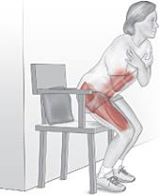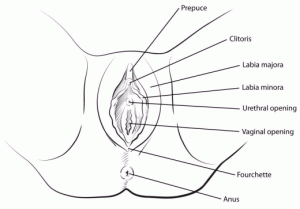After menopause, more than half of women may have vulvovaginal symptoms that can impact their lifestyle, emotional well being and sexual health. What’s more, the symptoms tend to co-exist with issues such as prolapse, urinary and/or bowel problems. But unfortunately many women aren’t getting the help they need, despite a growing body of evidence that skilled pelvic rehab interventions are effective in the management of bladder/bowel dysfunctions, POP, sexual health issues and pelvic pain. Continue reading “Pelvic Health at Menopause”
Tag: pelvic health
All Things Down Under!
Progressing your pelvic floor training
While it can initially be very useful to find and activate/relax your pelvic floor muscles in supine or side lying (have you seen the free download about this on the Resources page?!), it’s really not a good long term or functional strategy – the pelvic floor needs to actively work in a number of different positions and in a number of different activities and in coordination with the breath.
Once you have mastered the art of contracting, relaxing, lengthening and relaxing the pelvic floor muscles in a supine or side lying position, try it in sitting (on a firm chair to start with – you can try sitting close to the edge so that when you contract your pelvic floor you can feel it lift up and in and away from the surface of the chair & then relaxing back down again)
In standing, try and keep even weight on both feet and really bring your attention to the movement of the breath as you close the openings, lift up and in and then relax the pf muscles back down again.
Progressing to Movement:
The Knack: Ashton Miller et al first described this pre-emptive tightening of the pelvic floor before a sudden increase in intra abdominal pressure (such as a cough or a sneeze) back in 1998 and it was reviewed again in 2008
Essentially it involves bracing the pelvic floor for a sudden increase in pressure – as stated above, perhaps a cough or a sneeze, but also applicable for going from sitting to standing. Incorporating ‘The Knack’ into every transfer from sit to stand with emphasis on breathing and pf coordination can really enhance the efficiency of the lumbo-pelvic stability system
Try this: Sit close to the edge of your chair. Fold your arms (this way you won’t be tempted to push down on the arms of the chair!)
Take a deep breath in, as you exhale, relax your pelvic floor
Take another breath in, this time with the exhale, close the opening of your pelvic floor and lift up and in as you stand up (Don’t forget to keep breathing!)
Once you are standing, relax the pelvic floor (and again, don’t forget to breathe!). Many women (especially those who do have some incontinence problems, are concerned they will leak if they fully relax their pelvic floors. This is an important mis-conception to address. By being able to fully relax their pelvic floors, they will actually gain a greater spectrum of movement when they contract their pf muscles, promoting a faster return to continence and control than simply
‘Tighten! Tighten! Tighten!)
We need to be able to have a full spectrum range of motion and control with our pelvic floor muscles – for continence control, for sexual health and for avoiding problems with back pain or even pelvic organ prolapse
In my next blog post we will look at how we can incorporate more dynamic and challenging movements into our pelvic floor training programmes.
See you then!
Mx
3rd Age Women
Interested in learning more about peri-menopausal health?
Here is a link to some videos from the 3rd Age programme that Jessica Drummond, Jenny Burrell and I have created. Watch Jessica and I talk about creating optimal health for women as they move through and beyond menopause, creating pathways for health on every level of self care – using knowledge, food, exercise and mind-body strategies to optimise your well-being (and the well being of the women you know and work with)
Interested in learning more? Our online certification in 3rd Age women’s health opens again on July 20th. Hope to see you in class!
Knowledge is Power!
Anyone who knows me (for more then 5 minutes) knows I have a passion for women’s health. Particularly pelvic health. I have been accused of being ‘obsessed with the undercarriage’. Hey, it makes for great dinner party conversations! I think we need to think and talk more about pelvic health, particularly that it’s never normal to have pain, and leaking is never normal (common, yes. Normal, NO!) And there is almost always something that can be done about it…
But how can we know what IS normal?
Many of us know more about our phones than we do about our own anatomy…until today! I want to get every woman performing monthly self exams. We have come a long way in heightening awareness of the importance of breast self exams for women (and testicular self exams for men) but vulvar self exams are unfortunately not the norm…yet.
There are a number of vulvar conditions that affect women throughout their lifecycle. Without exception, these conditions respond to treatment best when treated early. Don’t be shy or embarrassed about performing vulvar self exams; like any other skill, its easy once you know how
Check your vulva monthly unless: You have recently had a baby or a miscarriage or you have recently had a gynecologic procedure: in these situations, check with your doctor that you are fully healed before beginning self vulvar exams.
Position yourself comfortably, propped up in bed.
Make sure your hands are clean
Don’t use any creams or lotions, as this may interfere with your ability to detect any changes
Holding a mirror in one hand and use your other hand to separate the labia and look at your vulva.
Check the clitoris and the surrounding area
Then move down to the vaginal opening. Check the small folds of skin to the left and right.
Now move down to the area around the anal opening because vulvar disease can spread to here.
If you notice:
• Any lumps, bumps or skin changes
• Itching
• Pain
• Burning sensation, especially after urinating
• Any unusual discharge
• That you bleed after sex
• That you bleed between periods OR after menopause
Then make an appointment to see your doctor – as soon as possible
Some symptoms could be from a minor condition but sometimes they can be indicators of something more serious, so always get symptoms checked.
You get your car checked and serviced regularly – don’t you think you should pay the same attention to your own undercarriage?










